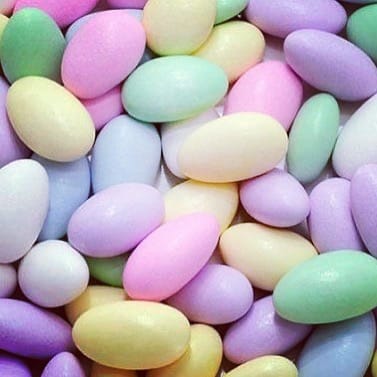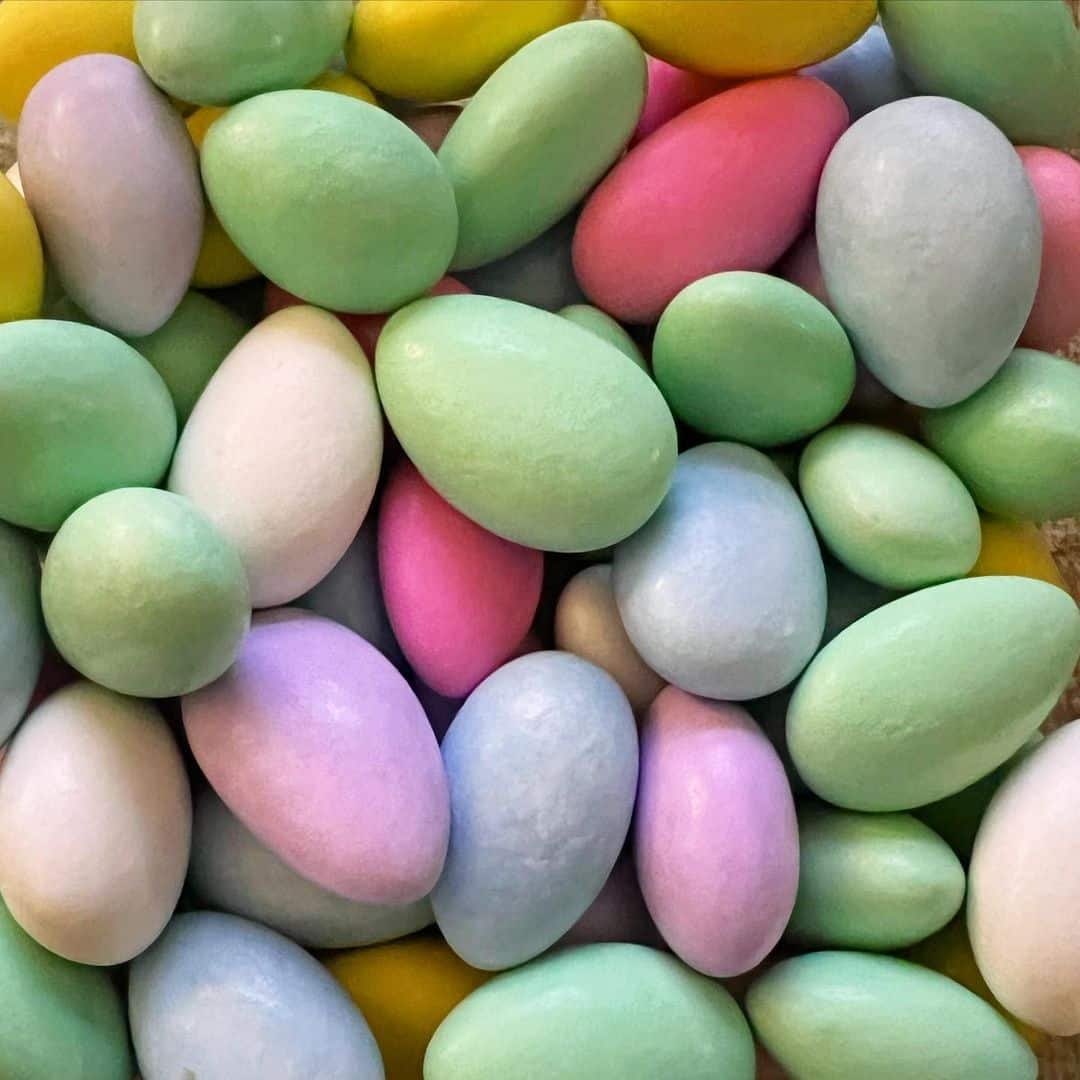Jordan Almonds (History, Ingredients & FAQ)
This candy goes by many names, and there are lots of ways to refer to it. You will find that some people call them Dragee, which is the French name for them. In Italy, they are known as Confetto or Malbas, while in the UK they are often referred to as a sugared almond. Jordan Almonds have been around for a very long time and have the distinction of having been created by people all over the world in different cultures. There are not many confections that can boast of this claim and this makes Jordan Almonds a very unique candy.
Whatever name this confection goes by, this is a classic sweet that has been around for a very long time. This is one of the candies that is old enough to have been used for medicinal purposes, and the simple design of the candy shows you that this was the original reason for its invention. These kinds of classic, panned candies are still popular today even if they are not as common as they once were.
Please leave a review or any memories of this snack in the comments at the bottom of this page. Thank you!

History
Jordan Almonds heralded from France where the first of them were made to copy the Greek version which is called Koufeta. The treat was and still is made using the classic candy-making method called panning. In this traditional candy creation method, a central item that is hard, such as an almond, is used for the core of the candy. The core of the candy is then dipped into different liquid sugars to make a sweet treat with a unique item at the core. This is how candies like Jawbreakers were made and the candy might have various layers of colored sugar candy throughout due to the way that the dipping process works.
Jordan Almonds were and still are, used as wedding favors once they were no longer being utilized to deliver medicine to people. The bitterness of the almond at the center of the candy offers a nice contrast to the sweetness of the candy layers. For many people, these candies were used as wedding gifts because they could represent the way that married life might go. You might have moments of sweetness but there will be bitter times as well. This was also a traditional candy that was given at Italian and Greek weddings and you might also see them offered in other countries as well at these kinds of events.
In the Middle East, Jordan Almonds are actually considered an aphrodisiac, which communicates an entirely different social experience when they were given out. The Romans likely created a similar sweet that was sweetened with honey rather than sugar. Nuts were a large part of the diet of Romans in certain parts of the empire and they were called confetti when given at weddings and parties. This is the origin of the paper confetti that we know and love at parties today, but this version was edible.
When sugarcane started to be cultivated and used for European sweet making, the modern panned sweet came to be. This was a perfect candy-making process for the use of this new sweetener since the sticky sugar product was easy to layer and dried quickly in between dips. The original candies that were made in Europe using this method might have almonds at the center of them but they could also have aromatic seeds, hazelnuts, pine nuts, or even cinnamon. These candies were served at weddings and feasts and were also given as gifts.
Panned chocolates and candies are not the only option for candy-making these days, but panned chocolates are still very enjoyable. They also still survive really well when it’s hot out, which means that they have remained one of the most popular outdoor wedding sweets to this day. If you are looking into the Renaissance history of these candies, you might be confused because these kinds of sweets were often referred to as “sweetmeats”.
This term actually carried forward even into the mid-1800s, and people often wonder what exactly this term means. Jordan almonds fall into this category, but there is an entire list of different confections made with sugar and using the panning method that falls under this heading.
Confusingly for some people, other jellied kinds of treats might also be referred to in this way. Jordan Almonds were more frequently called by their actual name due to the expense and specialness of the nuts that were inside of them, but you could still consider any generic reference to sweets during the Renaissance to include these candies. You can also assume that any wedding or feast of some kind would have included these candies, even if they are not called out specifically by name in whatever literature or research you are browsing.
The name Jordan Almonds is potentially a mispronunciation of the French word Jardin which means garden. This was in reference to a cultivated wild almond for the center of each sweet. There is an urban myth that this was also in reference to almonds grown along the banks of the Jordan River.
This is probably not the case but there is a very specific kind of almond that is grown along the river in Jordan that are long, thin, and slender with smooth and heavy shells. Another belief is that the name comes from the name of the town near Verdun in France. This was one of the sources of the almonds that were brought to Europe during the crusades, so this is much more likely the real reason for the name.
Today, there are many companies that make these products, but one of the best-known producers is in Italy. This company is in the Abruzzo region and they have been known for making the most famous confetti in the world for three centuries. A single family manufactures this Jordan Almond product using a recipe that has not changed since the company was formed. This is a great option if you want to try the Jordan almonds that were eaten in the Renaissance or slightly later periods when this sweet was at the height of its popularity.
You can still enjoy the Jordan almonds that you get locally, and there are many different versions these days. You can get white Jordan almonds for weddings and most companies that make these treats also sell multi-colored Jordan almonds for events like Easter. The colorful version is commonly offered in Easter baskets each year or they can be used as snacks at parties that are offered in bowls or dishes for guests to access as they mingle.
There are many companies that make Jordan almonds and they might sell them under different names. You can verify that this is what kind of treat you are getting just by looking at the ingredients to see if a whole almond is included in the recipe.
Jordan Almonds and Wedding Traditions
Since Jordan almonds are almost always associated with weddings, we should discuss the wedding traditions that go along with them. One of the key things that people observe who are giving these treats at weddings is that they should be offered in uneven numbers and usually five at a time. This is to indicate the qualities that weddings must have: health, fertility, wealth, longevity, and happiness. The uneven number rule is meant to indicate that the newlyweds will share everything equally and will remain undivided.
One of the other traditions is that they are packaged in sheer fabric and tied with a bow. There are sometimes thoughtful sayings, psalms, or other messages that are attached to little slips of paper tied onto the ribbon. These are usually placed on the tables at the meal that is served for the wedding, but they might be passed out as people come in for the ceremony.
In Greece, female guests place a packet of almonds under their pillows before the wedding or even after in the case of the bridesmaids and unmarried guests, with the hopes that they will dream of the man that they will marry. In the Middle East, the candies are considered aphrodisiacs and are eaten in settings where this would be more appropriate than at a wedding.
Ingredients
From one of the many companies that sells these candies. This is for the multi-colored version:
- Sugar
- Almonds
- Wheat flour
- Dextrin
- Corn syrup
- Artificial flavor
- FD&C Yellow Lake #5
- Yellow #6
- Red #3
- Red #40
- Blue lake #1
- Blue lake #2
- Titanium dioxide
- Carnauba wax
- Confectioner’s glaze
This particular recipe also carries warnings about being exposed during processing to milk, egg, soy, wheat, peanuts, and tree nuts. This is likely the case at most manufacturers, so you need to be aware of that if you are looking at these snacks as an option for your party which includes people with food allergies.
Nutrition
| Serving Size: | 1 piece (4.5g) | % Daily Value* |
| Amount Per Serving | ||
| Calories from Fat | 5.5 | |
| Calories | 20 | |
| Total Fat | 0.6g | 1% |
| Saturated Fat | 0.1g | 0% |
| Trans Fat | 0g | |
| Polyunsaturated Fat | 0.1g | |
| Monounsaturated Fat | 0.4g | |
| Cholesterol | 0mg | 0% |
| Sodium | 1.3mg | 0% |
| Potassium | 9mg | 0% |
| Total Carbohydrates | 3.5g | 1% |
| Dietary Fiber | 0.1g | 1% |
| Sugars | 2.1g | |
| Protein | 0.3g | |
| Vitamin A | 0% | |
| Vitamin C | 0% | |
| Calcium | 0.3% | |
| Iron | 0.3% |
- Percent Daily Values are based on a 2000 calorie diet.
Pictures


Videos:
A Jordan Almond candy-making video that is very informative about the creation process:
A candy blogger’s entry about this sweet:
FAQ
What are Jordan Almonds?
Jordan almond, or Sugared almond in the U.K, is a bite-sized form of confectionery with a hard outer shell.

My name is Brianna and I love writing on all topics. Candy history fascinates me and I am passionate about sharing my love of this topic with everyone else!
Please leave a review or any memories of this snack in the comments below. Thank you!
Click here for a full A-Z list of Snacks and Candy
